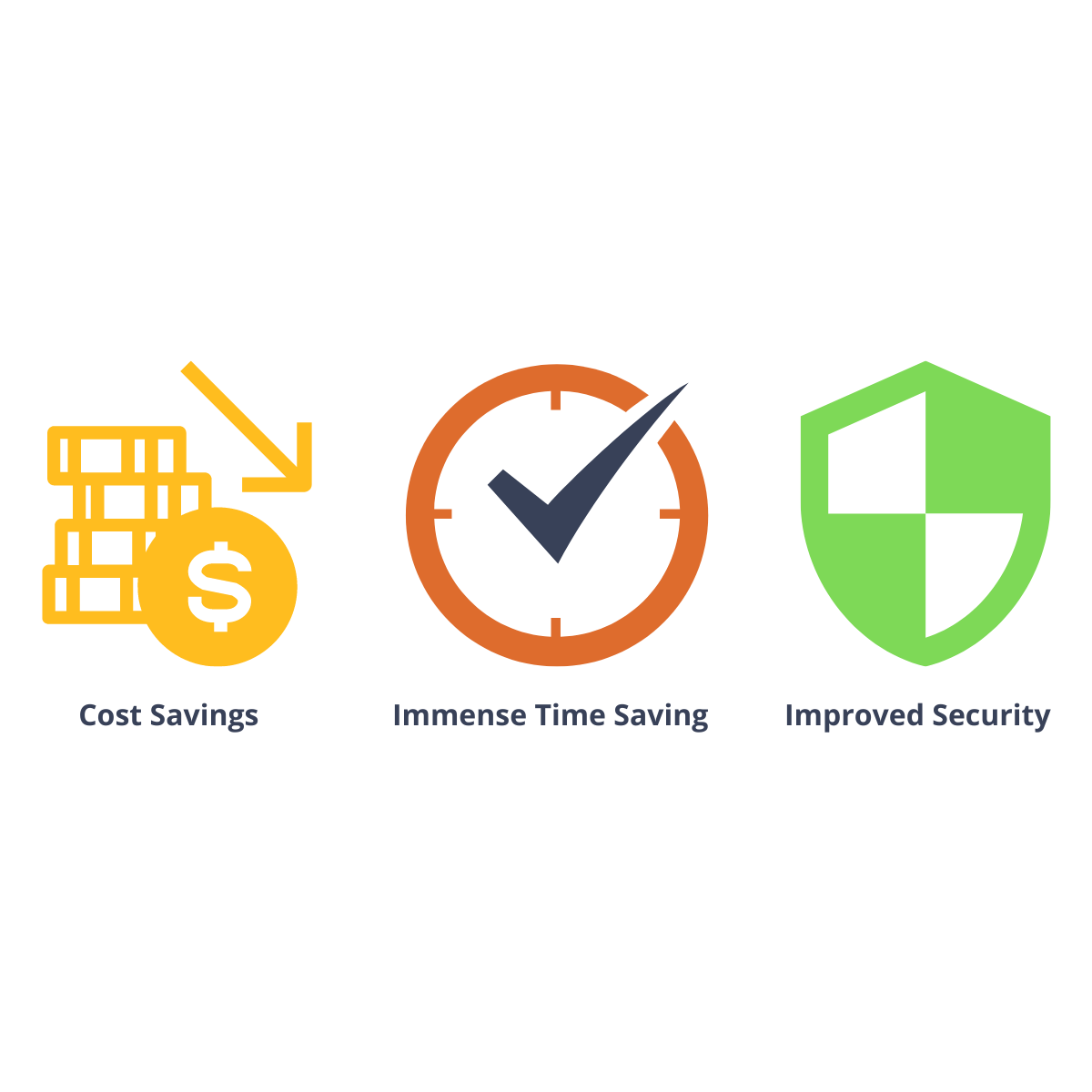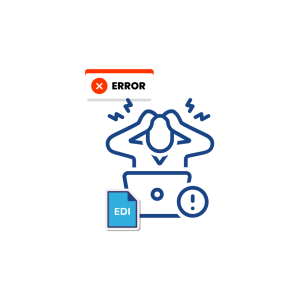Introduction to EDI
Electronic Data Interchange has changed the way businesses manage and process their information on a grand scale. EDI solutions save immeasurable amounts of time and lost revenue from clerical errors. Simply put, EDI provides a technical basis for commercial “conversations” between two entities, either internal or external.
60 EDI Benefits
1. Enhanced Efficiency
EDI eliminates manual data entry, reducing the risk of errors and enhancing operational efficiency.
2. Cost Reduction
By automating document exchange, EDI reduces paper-based processes, printing costs, and manual labor expenses.
3. Faster Transaction Processing
EDI enables real-time or near-real-time exchange of information, accelerating transaction processing times.
4. Improved Accuracy
Manual data entry is prone to errors, while EDI ensures accurate and reliable data transmission.
5. Increased Productivity
By automating repetitive tasks, EDI frees up employees’ time, allowing them to focus on more value-added activities.
6. Streamlined Supply Chain
EDI facilitates seamless collaboration between suppliers, manufacturers, and retailers, optimizing supply chain management.
7. Inventory Optimization
With EDI, businesses can receive accurate and timely inventory updates, reducing stock-outs and overstock situations.
8. Better Customer Service
Faster and error-free order processing through EDI leads to improved customer satisfaction.
9. Enhanced Partner Relationships
EDI promotes stronger relationships between trading partners by enabling smooth information exchange and collaboration.
10. Reduced Order Cycle Time
EDI shortens the time it takes to process and fulfill orders, resulting in faster order-to-cash cycles.
11. Increased Data Security
EDI incorporates encryption and authentication measures to ensure the secure transmission of sensitive business data.
12. Regulatory Compliance
EDI helps businesses comply with industry and government regulations by facilitating accurate and auditable data exchange.
13. Minimized Manual Interventions
EDI eliminates the need for manual intervention, reducing the risk of human errors and delays.
14. Global Reach
EDI enables seamless communication between international partners, facilitating global trade and expanding business opportunities.
15. Competitive Advantage
Organizations leveraging EDI gain a competitive edge by optimizing their processes, reducing costs, and improving efficiency.
16. Real-time Business Insights
EDI provides instant access to critical business data, empowering organizations to make informed decisions.
17. Scalability
EDI supports business growth by enabling efficient handling of increased transaction volumes without sacrificing performance.
18. Standardization
EDI employs industry-standard formats, ensuring consistent and uniform data exchange across different systems and partners.
19. Improved Cash Flow
EDI accelerates invoice processing and payment cycles, leading to faster cash flow for businesses.
20. Reduced Carbon Footprint
By eliminating paper-based processes, EDI contributes to environmental sustainability and reduces waste.
21. Error Tracking and Resolution
EDI systems facilitate error tracking, allowing prompt identification and resolution of issues in the document exchange process.
22. Enhanced Forecasting
With accurate and timely data available through EDI, businesses can improve demand forecasting and inventory planning.
23. Faster Time-to-Market
EDI streamlines product launch processes by expediting order processing, shipping, and delivery.
24. Efficient Transportation Management
EDI automates the exchange of shipping and logistics information, optimizing transportation management.
25. Improved Cash Application
EDI automates the reconciliation of invoices and payments, reducing manual effort and improving accuracy.
26. Seamless Integration with Enterprise Systems
EDI can integrate with various enterprise resource planning (ERP) and back-end systems, ensuring smooth data flow.
27. Reduced Administrative Overhead
EDI eliminates the need for paperwork, reducing administrative tasks and associated costs.
28. Better Data Visibility:
EDI provides real-time visibility into transaction status, enabling proactive monitoring and issue resolution.
29. Error Notification and Alerts
EDI systems generate alerts and notifications in case of errors or exceptions, enabling timely action.
30. Streamlined Procurement
EDI simplifies the procurement process by automating purchase orders, acknowledgments, and confirmations.
31. Improved Accuracy of Invoices
EDI eliminates manual data entry for invoice generation, reducing errors and discrepancies.
32. Efficient Returns Handling
EDI expedites the processing of return orders, facilitating faster returns handling and replacement processes.
33. Improved Forecast Accuracy
EDI enables accurate data exchange between partners, leading to improved forecast accuracy for demand planning.
34. Enhanced Supplier Performance
EDI provides visibility into supplier performance metrics, enabling better supplier management and collaboration.
35. Automated Sales Reporting
EDI automates sales reporting, allowing businesses to analyze sales data and make informed decisions.
36. Simplified Tax Compliance
EDI enables automated tax calculation and reporting, ensuring compliance with tax regulations.
37. Accelerated New Partner Onboarding:
EDI simplifies the process of onboarding new trading partners, reducing time and effort.
38. Reduced Order Errors
With EDI, the risk of order errors due to manual data entry is significantly minimized, leading to improved order accuracy.
39. Better Cash Flow Forecasting
EDI provides real-time visibility into payment status, facilitating accurate cash flow forecasting.
40. Improved Trading Partner Relationships
EDI promotes transparency and collaboration with trading partners, strengthening relationships.
41. Enhanced Warehouse Management
EDI automates the exchange of advanced shipping notices (ASNs), enabling efficient warehouse management.
42. Reduced Lead Time
EDI reduces the time required for order processing, resulting in shorter lead times for customers.
43. Efficient Just-in-Time (JIT) Inventory:
EDI facilitates the timely exchange of demand and inventory data, supporting JIT inventory management.
44. Reduced Invoice Processing Costs:
EDI eliminates the need for manual invoice processing, reducing associated costs and effort.
45. Improved Payment Accuracy
EDI eliminates discrepancies between invoices and payments, improving payment accuracy and reducing disputes.
46. Streamlined Claims Processing
EDI expedites the exchange of information for insurance claims, reducing processing time and improving customer satisfaction.
47. Improved Data Integrity
EDI ensures data accuracy and integrity through standardized formats and validation rules.
48. Optimized Sales Order Processing
EDI automates the processing of sales orders, reducing manual effort and improving order fulfillment.
49. Efficient Communication with 3PL Providers
EDI enables seamless information exchange with third-party logistics (3PL) providers, improving coordination.
50. Enhanced Forecast Collaboration:
EDI facilitates collaborative forecasting between suppliers and customers, improving supply chain planning.
51. Reduced Order Confirmation Time
EDI enables instant order confirmation, reducing the time required for customers to receive confirmation.
52. Simplified Customs Documentation
EDI automates the preparation of customs documentation, reducing delays and improving customs clearance.
53. Improved On-time Delivery
EDI enables real-time tracking of shipments, reducing delays and improving on-time delivery performance.
54. Centralized Document Management
EDI consolidates and centralizes business documents, simplifying document retrieval and management.
55. Seamless Integration with E-commerce Platforms
EDI integrates with e-commerce systems, enabling efficient order processing for online sales.
56. Simplified Product Catalog Management
EDI automates product catalog updates, ensuring consistency across trading partners.
57. Enhanced Product Data Accuracy
EDI eliminates manual data entry for product information, reducing errors and ensuring accurate data exchange.
58. Improved Order Visibility
EDI provides real-time visibility into order status, enabling proactive order tracking and customer communication.
59. Effective Business Continuity
EDI ensures uninterrupted document exchange, even during disruptive events or system failures.
60. Future-Proof Technology
EDI continues to evolve, incorporating new standards and technologies, ensuring its relevance in the digital era.
Conclusion
Electronic Data Interchange (EDI) has revolutionized the way businesses communicate, offering numerous benefits across various industries. From improved efficiency and cost reduction to enhanced supply chain management and better customer service, the advantages of EDI are vast. By adopting EDI, organizations can streamline their operations, gain a competitive edge, and unlock new levels of collaboration and efficiency in today’s digital business landscape.
Want to learn more about Commport EDI Solutions?
Download: EDI Buyers Guide
Unlock the full potential of your supply chain with our comprehensive EDI Buyer's Guide — your first step towards seamless, efficient, and error-free transactions
Frequently Asked Questions
Electronic Data Interchange (EDI) offers several advantages, including increased efficiency, reduced manual errors, faster transaction processing, improved data accuracy, and enhanced overall business productivity.
EDI eliminates the need for manual data entry, paper-based processes, and postal expenses. This automation results in significant cost savings by reducing labor hours, paper usage, and the likelihood of errors associated with manual data handling
Yes, EDI fosters stronger relationships with trading partners by streamlining communication, reducing order processing times, and ensuring accuracy in transactions. It promotes real-time data exchange, leading to improved collaboration and responsiveness between business partners.
EDI minimizes the risk of errors caused by manual data entry, illegible handwriting, or misinterpretation of information. The standardized electronic format ensures consistency, leading to more accurate and reliable exchange of business documents, such as invoices, purchase orders, and shipping notices.
EDI benefits businesses of all sizes. While larger enterprises may experience more immediate efficiency gains due to higher transaction volumes, smaller businesses also benefit from reduced operational costs, improved accuracy, and the ability to compete more effectively in the marketplace by meeting the electronic trading requirements of larger partners.





